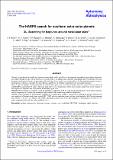Files in this item
The HARPS search for southern extra-solar planets. XL. Searching for Neptunes around metal-poor stars
Item metadata
| dc.contributor.author | Faria, J. P. | |
| dc.contributor.author | Santos, N. C. | |
| dc.contributor.author | Figueira, P. | |
| dc.contributor.author | Mortier, A. | |
| dc.contributor.author | Dumusque, X. | |
| dc.contributor.author | Boisse, I. | |
| dc.contributor.author | Lo Curto, G. | |
| dc.contributor.author | Lovis, C. | |
| dc.contributor.author | Mayor, M. | |
| dc.contributor.author | Melo, C. | |
| dc.contributor.author | Pepe, F. | |
| dc.contributor.author | Queloz, D. | |
| dc.contributor.author | Santerne, A. | |
| dc.contributor.author | Ségransan, D. | |
| dc.contributor.author | Sousa, S. G. | |
| dc.contributor.author | Sozzetti, A. | |
| dc.contributor.author | Udry, S. | |
| dc.date.accessioned | 2016-05-11T11:30:07Z | |
| dc.date.available | 2016-05-11T11:30:07Z | |
| dc.date.issued | 2016-05 | |
| dc.identifier | 242360642 | |
| dc.identifier | 4b64c468-191b-4021-899c-0e7868b5e6ff | |
| dc.identifier | 84964342459 | |
| dc.identifier | 000375318300037 | |
| dc.identifier.citation | Faria , J P , Santos , N C , Figueira , P , Mortier , A , Dumusque , X , Boisse , I , Lo Curto , G , Lovis , C , Mayor , M , Melo , C , Pepe , F , Queloz , D , Santerne , A , Ségransan , D , Sousa , S G , Sozzetti , A & Udry , S 2016 , ' The HARPS search for southern extra-solar planets. XL. Searching for Neptunes around metal-poor stars ' , Astronomy & Astrophysics , vol. 589 , A25 . https://doi.org/10.1051/0004-6361/201527522 | en |
| dc.identifier.issn | 0004-6361 | |
| dc.identifier.other | BibCode: 2016A&A...589A..25F | |
| dc.identifier.uri | https://hdl.handle.net/10023/8776 | |
| dc.description.abstract | Context. As a probe of the metallicity of proto-planetary disks, stellar metallicity is an important ingredient for giant planet formation, most likely through its effect on the timescales in which rocky or icy planet cores can form. Giant planets have been found to be more frequent around metal-rich stars, in agreement with predictions based on the core-accretion theory. In the metal-poor regime, however, the frequency of planets, especially low-mass planets, and the way it depends on metallicity are still largely unknown. Aims: As part of a planet search programme focused on metal-poor stars, we study the targets from this survey that were observed with HARPS on more than 75 nights. The main goals are to assess the presence of low-mass planets and provide a first estimate of the frequency of Neptunes and super-Earths around metal-poor stars. Methods: We performed a systematic search for planetary companions, both by analysing the periodograms of the radial-velocities and by comparing, in a statistically meaningful way, models with an increasing number of Keplerians. Results: A firs tconstraint on the frequency of planets in our metal-poor sample is calculated considering the previous detection (in our sample) of a Neptune-sized planet around HD 175607 and one candidate planet (with an orbital period of 68.42 d and minimum mass Mp sin i = 11.14± 2.47 M⊕) for HD 87838, announced in the present study. This frequency is determined to be close to 13% and is compared with results for solar-metallicity stars. Based on observations collected at ESO facilities under programs 082.C-0212, 085.C-0063, 086.C-0284, and 190.C-0027 (with the HARPS spectrograph at the ESO 3.6-m telescope, La Silla-Paranal Observatory). | |
| dc.format.extent | 18 | |
| dc.format.extent | 3655515 | |
| dc.language.iso | eng | |
| dc.relation.ispartof | Astronomy & Astrophysics | en |
| dc.subject | Methods: data analysis | en |
| dc.subject | Planetary systems | en |
| dc.subject | Surveys | en |
| dc.subject | Stars: individual: HD 87838 | en |
| dc.subject | Techniques: radial velocities | en |
| dc.subject | QB Astronomy | en |
| dc.subject | QC Physics | en |
| dc.subject | NDAS | en |
| dc.subject.lcc | QB | en |
| dc.subject.lcc | QC | en |
| dc.title | The HARPS search for southern extra-solar planets. XL. Searching for Neptunes around metal-poor stars | en |
| dc.type | Journal article | en |
| dc.contributor.sponsor | European Commission | en |
| dc.contributor.institution | University of St Andrews. School of Physics and Astronomy | en |
| dc.identifier.doi | https://doi.org/10.1051/0004-6361/201527522 | |
| dc.description.status | Peer reviewed | en |
| dc.identifier.url | http://adsabs.harvard.edu/abs/2016A%26A...589A..25F | en |
| dc.identifier.grantnumber | en |
This item appears in the following Collection(s)
Items in the St Andrews Research Repository are protected by copyright, with all rights reserved, unless otherwise indicated.

